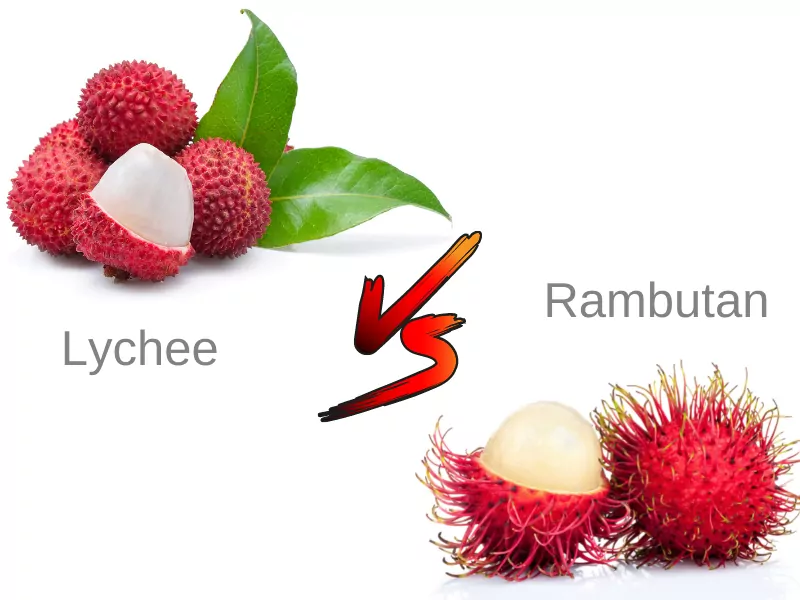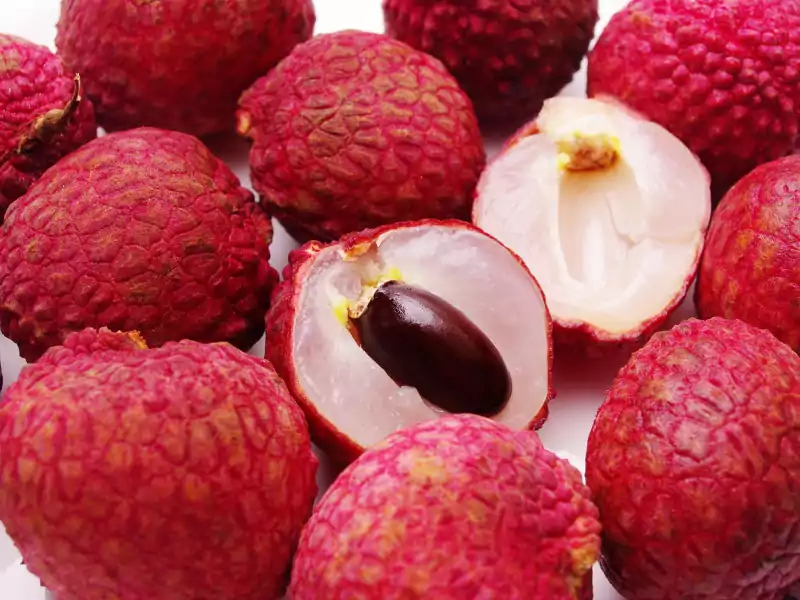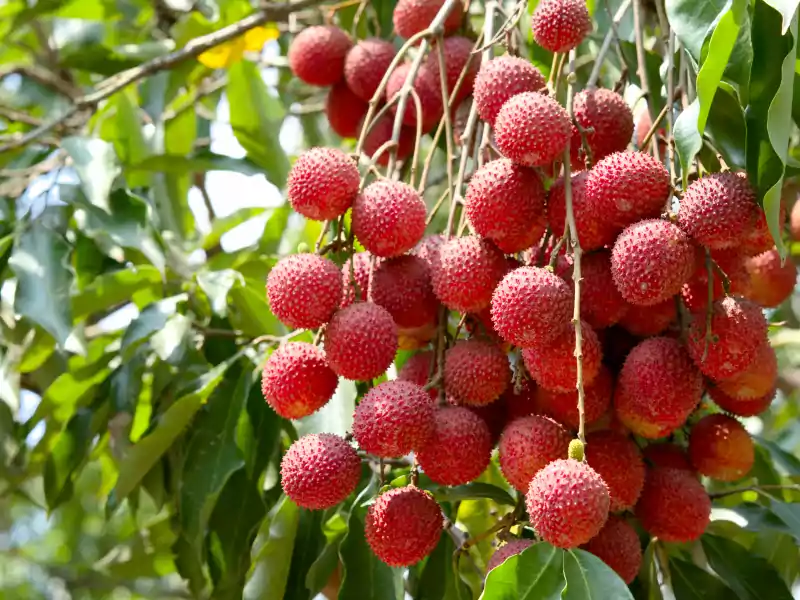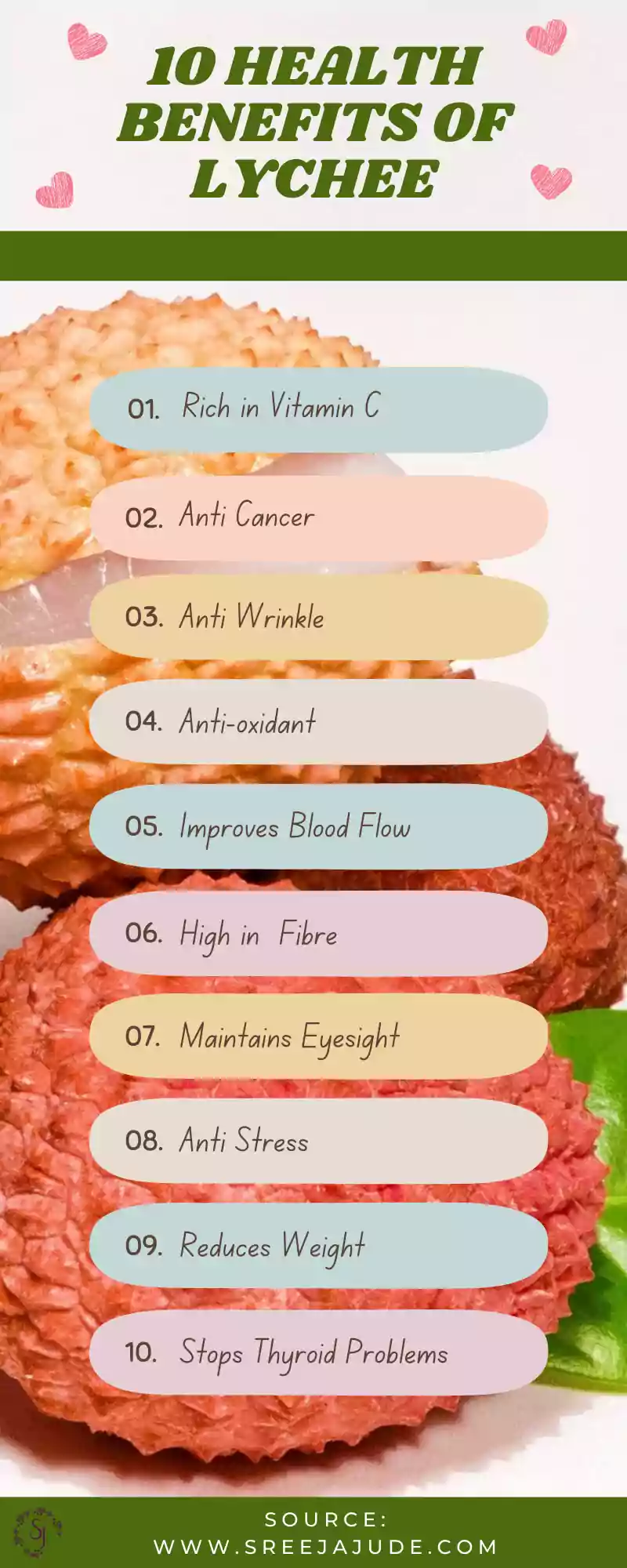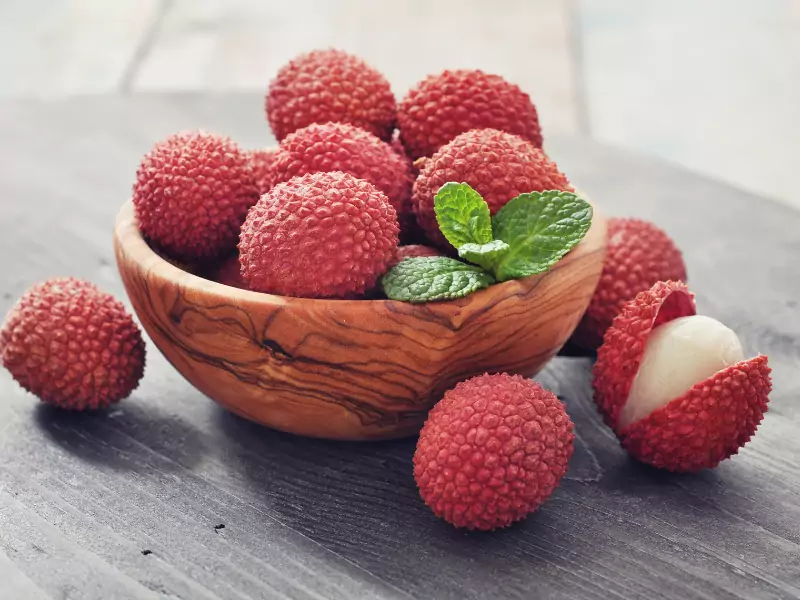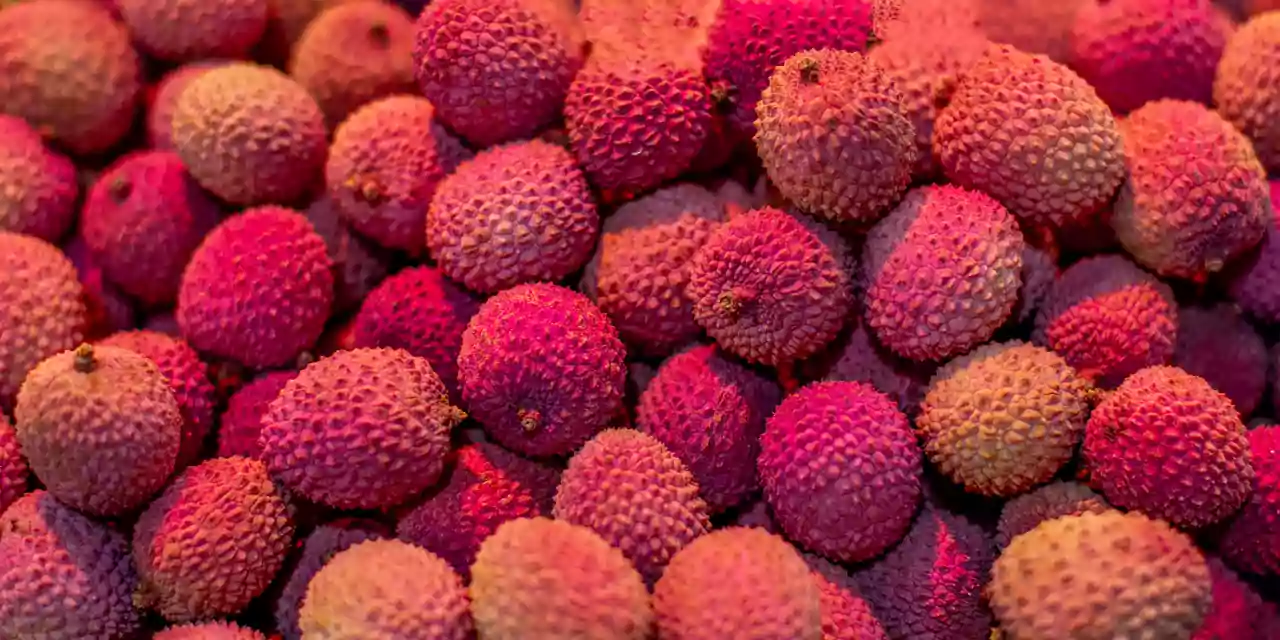
What is Lychee | What does it Taste Like
Lychee is one of the most alluring types of fruit with a wonderful taste that you can eat. Lychee tree itself, Litchi chinensis, is a large, long-lasting subtropical evergreen that bears fruit from May to August.
The most notable of the soapberry family, Sapindaceae, Litchee trees bloom in late winter through early spring.The inside of the fruit is whitish, semi-transparent and juicy. Each stone fruit contains a shiny, dark brown seed.
The white pulp of the lychee is very slippery and a bit like a jelly. It tastes very sweet and alluring, some people say it tastes similar to rose oil. Ultimately, however, the taste of lychee cannot be compared with the types of fruit that grow in Europe. You just have to try them.
What exactly is this Lychee fruit?
Lychees are originally from China. The lychee is also sometimes referred to as Chinese hazelnut or love fruit. It actually belongs to the genus of the soap nut family. The fruits themselves are 3 to 5 centimeters in diameter. Usually they are round or heart-shaped.
The delicate litchi bowl is thin, pink to red and rough. It becomes brownish in older fruits. The shell hardens in a characteristic manner only after it has been harvested.
Litchis are classified as nuts because all three layers of the pericarp are lignified or dry-skinned.
- The ripe lychee has a pinkish red to dark red nubby skin – this thin and easily removable skin is not edible.
- The pulp is white and glassy, tastes very sweet, slightly sour, has a weak, bitter aftertaste, a note of nutmeg and smells a little like roses.
- The inner core of lychee(looks like a chestnut) is not good to eat.
Lychees grow on the evergreen lychee tree. This can be up to 10 meters high and well over 100 years old and bears between 100 and 200 kilograms of fruit annually. That corresponds to a total of almost 24,000 fruits. The lychee is a sweet fruit with a very fine consistency that not only looks and taste good on the plate, but also brings a large amount of nutrients with it.
Lychee vs Rambutan, What’s the difference?
Lychee and rambutan are sweet-tasting tropical fruits that look very similar. They both have white flesh, contain a large seed as their center, and have rough, red skin. But despite their similarities, these fruits are very different in terms of flavor and nutritional profiles.
Most of us aware of lychees, that are an alluring fruit that’s usually found in Asia, however is also grown throughout the globe. The rambutan is also a close relative of the Lychee and is also widely used in Asia.
1. Difference in Appearance
Fruit size, color, and texture are unique, and knowing the difference will help you determine which is which at a glance.
- Lychee is slightly smaller and sweeter than rambutan and has softer skin, while rambutan is the size of a golf ball, has a slightly more acidic taste, and has hair-like spines that cover its skin.
- Rambutan and lychee also have different outer skins. The rambutan has a red outer skin, which has thin tips around the shell, which can be green or orange, or a color in between.
- Lychee skin is thinner. It is a rough surface but does not have points like rambutan, and it is a more intense red color, which can also be slightly brown.
- The skin of both rambutan and lychee has very unique appearances, but the pulp of both fruits is more alike. They both have white flesh that has a large seed or hole in the middle.
- As both fruits ripen, they turn from green to dark red, almost brown. You will also struggle to open either one if they are not ripe, as the skin is tough and harder to peel.
2. Difference in Taste
Although the pulp of rambutan and lychee looks similar, they both have their own distinctive flavor. While they both have a fresh tropical flavor, you can still tell the difference between the two with just one bite!
- The pulp of a it has a wonderfully crunchy bite and a sweet, floral taste. Lychee can sometimes have a slight flavor, but the sweetness balances it out wonderfully, you may experience it when you eat lychee
- The flavor of rambutan is slightly different from lychee. Rambutan has a creamier flavor, which leads to a much richer flavor. The sweetness of the rambutan plays perfectly with the acidity that it can sometimes have as well.
3. Difference in Cultivation
While the two fruits are considered raw, they originated from different areas of Asia.
- Lychee grows best in areas with high humidity and rainfall, in a frost-free tropical climate. While rambutan grows best in deep soils with sandy loam, in mountainous terrain that offers good drainage.
- Lychee is easier to grow, and this has seen it spread around the world to other subtropical regions. Rambutan has not spread far outside of Southeast Asia, it has only been found to grow in Central America.
4. Difference in Nutritional Content
The best thing about rambutan and lychee is that they both taste absolutely delicious and are still really good for you. Both are packed with a variety of vitamins, minerals, and antioxidants, which we could all do with a little more!
- Rambutan stands out when it comes to health benefits. Rambutan is believed to help lower the risk of diabetes, as it has a considerably low sugar content.
- It also has a large amount of vitamin C, which can help boost the immune system.
- Lychee has a good content of vitamin C, in addition to a complex of vitamin B, phytonutrient flavonoids and manganese, magnesium, copper, folate and iron.
- Lychee is also high in antioxidants that helps prevent premature aging.
Both fruits, lychee and rambutan are a great source of essential vitamins and minerals, and because they taste so good too, there’s no reason why you shouldn’t eat them!
What does Lychee taste like?
Not all lychees taste the same. Unripe fruits are slightly sour, while overripe lychees ferment quickly and taste alcoholic. They are then inedible. Only really ripe lychees have an intense taste, which is why you should pay attention to the selection of ripe fruits when buying. If the skin of the lychee is relatively dark and flexible, it is a ripe fruit.
Lychee is sweet, with slightly floral and acidic notes. Upon biting, you’ll get a juicy flavor burst with a taste kind of like a strawberry or pear with a touch of citrus. The flesh of the lychee is relatively firm and has to be chewed well, but its sweet taste delights fruit lovers from all over the world.
How to Eat Lychee
Mainly, it is important not to consume this fruit when it is green, when the fruit is not yet ripe. They have been found to contain toxins that are harmful to health. Especially in people who suffer from malnutrition.
- Pick up a lychee to peel it. It’s best to hold it with the pointed side up.
- Now carefully press the fingernail of your thumb into the shell, preferably in the middle area of the lychee. Be very careful not to injure yourself and prevent juice from leaking out of the lychee. You can also do this step with a knife by pressing the blade onto the litchi bowl.
- The shell is a piece split open, cancel it with the edge of the thumb gently, similar to the one Pellen ice.
- Break off the litchi bowl piece by piece, so that you get a ring around the center of the litchi.
- Now you can simply remove the upper and lower part.
- When consuming it, keep in mind that it also have kernels that you cannot eat.
Alternatively, as soon as you have broken out a piece of the peel, you can also press the lychees lightly on the peel. If you are lucky, the entire shell will break through and you can easily remove it.
How to Use Lychee
If you want to feel the real taste of lychee and want to give the body the maximum number of vitamins, then eat the white pulp of fresh fruits. Eat fruit like a common plum or a teaspoon.
Here are some nice ways to enjoy lychee:
- The lychee goes okay in fruity salads, alcoholic mixed drinks, desserts and alternative sweet dishes.
- Cold bowls or frozen dessert also can be made okay from the lychee.
- A glass of dry vino with a contemporary edible fruit in it provides it a special aroma.
- Of course, the lychee is additionally very appropriate as a decoration. However, it shouldn’t be too ripe then. It is suggested to use the complete fruit for adornment, which might visually enhance a chilly buffet or cold platters.
- Unfortunately, they cannot be skewered like grapes, because of the big kernel.
- To vanilla frozen dessert served merely besprent with sugar as a dessert with topping or edible fruit could be a true delicacy.
Health Benefits of Lychee
The lychee contains a lot of vitamin C (around 40 milligrams of vitamin C are in 100 grams), for which humans have a wide range of uses in their bodies. It also contains provitamin A, vitamins B1 and B2, phosphorus, magnesium, calcium and potassium.
Nutritional values of lychees per 100 grams
| Calories | 75 |
| Protein | 0.9 g |
| Fat | 0.3 g |
| carbohydrates | 17 g |
| fiber | 1.6 g |
1. Strengthening Immunity
6 to 8 pieces a day are enough. If a person is already sick, the pulp of lychee having sweet taste will soothe a sore throat and help get rid of a cough.
2. Cardiovascular Disease Prevention
Due to the high content of potassium, magnesium and B vitamins, lychees are used for the prevention of diseases of the heart and blood vessels – hypertension, coronary artery disease, arrhythmia, myocardial infarction, atherosclerosis.
The fruit removes excess fluid from the body, “bad” cholesterol, promotes blood microcirculation and strengthens the walls of blood vessels.
3. Digestion and Weight Loss
Lychees remove toxins and insoluble compounds from the body. They have a mild laxative effect, so they are eaten up for chronic constipation.
Although it contains many simple sugars, lychee is good to eat for those who are on diet. The fruit speeds up metabolism: fats and carbohydrates that enter the body are converted into energy and not passed on to the fat store. B vitamins and copper prevent neuroses due to dietary changes.
4. Improvement of the Condition of the Skin, Hair and Nails
With a great taste, lychee contains in large quantities substances with antioxidant properties: vitamins of groups B, C, amino acids. They increase collagen production. The latter makes the skin fresh, supple and the hair shiny. Phosphorus, calcium and magnesium strengthen bones, teeth and nails.
5. Favourable Pregnancy
Pregnant women are advised to eat lychee fruits because they contain folic acid, which stimulates red blood cell production and normalizes hormone levels. And this is the prevention of uterine bleeding, miscarriage and premature birth. Lychee also prevents deformities in the unborn child.
Side Effects of Lychee
Lychee is harmful in extremely rare cases. As a rule, unpleasant symptoms are associated with an overdose of vitamin C or copper when a person ingests fruits in kilograms.
“Unripe fruits can be harmful to health. They contain hypoglycin and methylenecyclopropylglycine. If you eat lychee on an empty stomach, these substances result in a sharp drop in blood sugar and poor health.”
Side effects that occur immediately:
- Rashes
- Irritation of the oral mucosa
- Nausea, vomiting, diarrhea
- Muscle pain, abdomen
- Intense thirst
- Dizziness Collapse
- Individual intolerance or allergy
- Increased acidity from gastric juice, ulcer, gastritis
- Gout, arthritis
Conclusion
Lychee is a unique tropical fruit that delights with its sweet, floral taste and refreshing texture. From understanding what it is to learning how to eat it, enjoy it fresh, or use it in recipes, this fruit offers both flavor and health benefits. Just remember to choose ripe lychees and consume them in moderation to fully enjoy everything they have to offer.
Frequently Asked Questions
Q: What fruit is mistaken for lychee?
A: The fruit most often mistaken for lychee is rambutan, which has a similar shape but a hairy peel and a slightly different texture and taste. Both are tropical fruits with sweet, juicy flesh.
Q: Why do I feel dizzy after eating lychee?
A: Feeling dizzy after eating lychee may be linked to low blood sugar or consuming unripe lychees on an empty stomach. It’s best to eat lychee in moderation and after meals.
Q: Can I eat litchi with milk?
A: While some enjoy combining litchi and milk in desserts, eating litchi with milk may cause digestive issues for sensitive individuals. Ayurveda often advises against this combination.
Q: What fruit goes best with lychee?
A: Fruits that go best with lychee include mango, pineapple, and berries, as their flavors complement the sweet lychee taste. These combos work well in smoothies and fruit salads.
Q: How to tell if lychee is bad?
A: You can tell if lychee is bad by checking for a sour smell, brown or cracked skin, or mushy, discolored flesh. Fresh lychee should have firm, white pulp and a sweet, floral scent.


